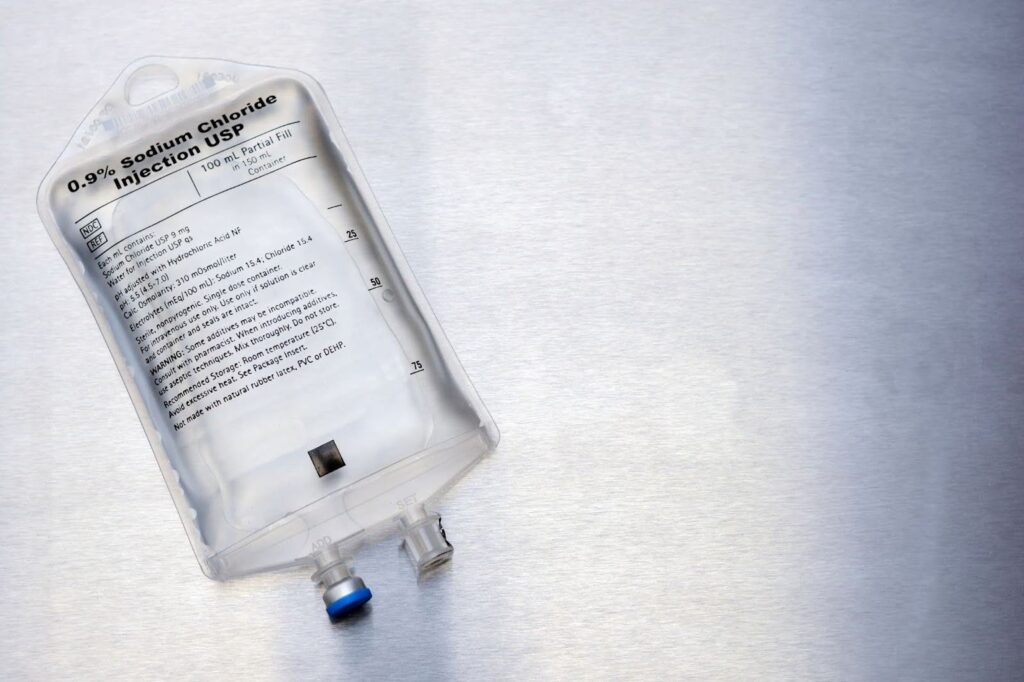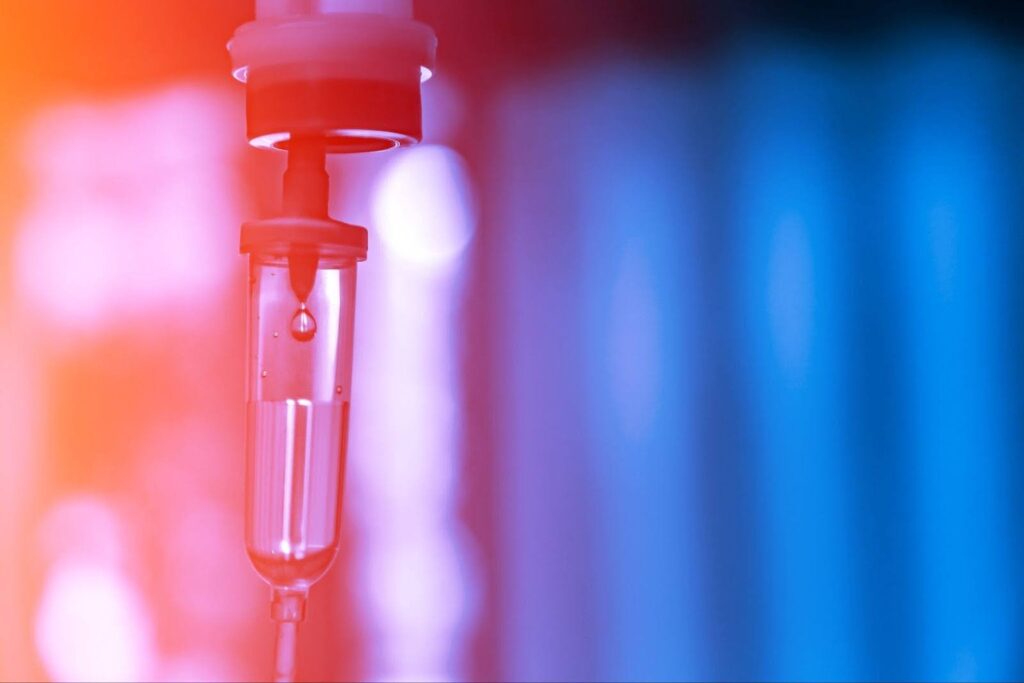IV bags are essential for healthcare as they may rehydrate the body faster than oral intake of medicine. IV fluids get absorbed directly into one’s bloodstream, meaning they may reach every cell immediately after administration. But what is in an IV bag?
The contents of an IV bag can vary depending on the patient’s needs. It often contains a sterile solution and electrolytes to help maintain the body’s fluid balance and support proper cellular function. In some cases, additional nutrients and medications are added to provide energy and support healing. Keep reading to find out what these components are and what are their roles.

Source: shutterstock.com / Photo Contributor: AlteredR
What Is in an IV Bag?
IV therapy is a treatment involving the administration of intravenous fluids via IV bags for various health and wellness purposes. Depending on the treatment’s purpose, IV bags may contain various fluids and solution blends. Still, the basic components of the fluid in an IV bag include the following:
Water – important for hydration, especially in cases of dehydration
Electrolytes – crucial components for maintaining normal body functions
Medications – certain medications are included to treat specific conditions
Nutrients – imperative ingredients for maintaining overall health
Other additives – vitamins, antioxidants, amino acids, etc., to offer necessary health and energy boosts
All of these IV bag components work together to boost and maintain the body’s health.
IV treatments serve various purposes, among which most often in dehydration cases. This is especially true for those living in warm climates like Arizona’s desert landscape. So, if you are looking for the best IV drip bags, AZ, The Drip IV Infusion is a premium mobile IV therapy company at your disposal.
Getting back to the basic IV therapy ingredients, in the following, you’ll find each of them elaborated on and their role in the therapy process.
Water
Proper hydration is vital for your overall health. Every system and organ in your body requires hydration to function properly. This is why water is a crucial component of every IV bag.
As you may know, human bodies comprise 60% water, making it essential to every cell in them. If a person doesn’t have sufficient water levels, they start experiencing dehydration, negatively impacting every system in the body.
Dehydration upsets the delicate balance of water and electrolytes. When the body is dehydrated, the person affected starts experiencing mental and physical symptoms like:
Confusion
Fatigue
Aching joints
IV fluid bags work to restore the upset balance by being administered directly into the bloodstream. But IV bags don’t just contain regular water in them. Instead, the water in IV bags is sterilized to prevent infection risks.
Sterilization removes all the harmful microorganisms from the water, such as bacteria, fungi, and viruses. This makes it clear what is the liquid in an IV bag and the following types of water are what IV bags mostly contain.
Salt solution
Due to dehydration, normal saline (or NS; 0,9% NaCl) is commonly used to increase the fluid volume. This type of IV fluid is a salt solution of purified water. As mentioned, you cannot introduce regular water directly into your bloodstream.
Plain water would cause all the salt in your body to get out of your cells and tissues where it is needed. Normal saline has approximately the same ratio of water to salt as naturally present in the body.
Sugar solution
The sugar solution (5% Dextrose in Water or D5W), also known as a dextrose solution also contains salt. A sugar solution is suitable for people who don’t have diabetes and aren’t too dehydrated. Dextrose fluids are usually great for controlling blood sugar levels to prevent infections during sickness.

Source: shutterstock.com / Photo Contributor: ANDRANIK HAKOBYAN
Ringer’s lactate solution
Ringer’s lactate solution is a sterile solution that contains a balanced blend of electrolytes and lactate. As a form of lactic acid, lactate may help regulate the body’s pH balance.
The solution is often used in treating dehydration and preventing the body from producing too much acid.
Electrolytes
Electrolytes are vital to sustaining the body’s regular function and are an important part of an IV bag. IV fluids may help restore electrolytes lost by the body due to illnesses like dehydration or electrolyte imbalances.
IV bags may support the patient’s general health and help the body function normally by giving the body the necessary electrolytes. Besides helping with bodily function, electrolytes also play a crucial role in regulating fluid.
Any disturbance in the delicate electrolyte balance in the body may have serious consequences for one’s health. This is why IV fluids contain electrolytes such as the following:
Sodium
Potassium
Calcium
Magnesium
Medications
Based on the patient’s medical state, medications given in IV bags may provide various benefits. So, if you wonder what is in a normal IV bag in terms of medication, it may be one of the following:
Benadryl – it is an example of an antihistamine used to treat allergic responses; it may reduce the effect of the natural histamine in the body
Toradol (Ketorolac) – it is a nonsteroidal anti-inflammatory medication that may aid in the reduction of the hormones causing inflammation and pain
Zofran – this medication is added to IV bags because it may block the activity of chemicals in the body that cause nausea and vomiting
Pepcid – this is a histamine-2 blocker medication that is intended to potentially decrease the amount of stomach acids produced.
By getting these medications through the IV bag directly into the bloodstream, the patient’s overall health may significantly improve.
Nutrients
Minerals are necessary for numerous body processes and may support general health and well-being by effectively supplying them to the body through IV solutions.
So, what is in an IV fluid bag regarding essential nutrients?
Zinc
As an indispensable mineral present in every body, zinc supports the function of the metabolic and immune systems. Even though you only need small amounts of zinc, it is vital for 100 enzymes that must carry out essential chemical reactions.
Zinc is involved in a variety of important functions, such as:
DNA creation
Protein building
Growth of cells
Damaged tissue healing
Suppose the body has a zinc mineral deficiency. In that case, it may affect the function of several tissues and organs, such as:
Bones
Skin
Digestive system
Central nervous system
Immune system
Magnesium
Magnesium is a natural mineral cofactor in over 300 enzyme systems regulating various biochemical reactions. Some of the biochemical reactions that need magnesium include:
Muscle function
Nerve function
Blood glucose control
Protein synthesis
Blood pressure regulation
Energy production
Other additives
Some of the following vitamins are most commonly added to IV fluid bags.
Vitamins like B12 and B-complex may improve neurological function and energy levels
Vitamin C might strengthen the immune system
Vitamin D3 may support healthy bones
Vitamin B3 might promote energy production and brain function
Proteins are made up of amino acids, also necessary for tissue healing and muscle contraction.
Amino acids with antioxidant qualities, such as glutathione and taurine, may shield cells from damage. Mixing amino acids into an IV bag might be a more effective and direct method of giving the body these vital nutrients.

Source: shutterstock.com / Photo Contributor: Numstocker
Conclusion
What is in an IV bag? As mentioned, IV fluids contain a blend of ingredients that work together to improve the wellness and health of patients. The most common IV ingredients include water, electrolytes, nutrients, minerals, etc. All of these components in the IV bag work in tandem to potentially boost the patient’s health.




